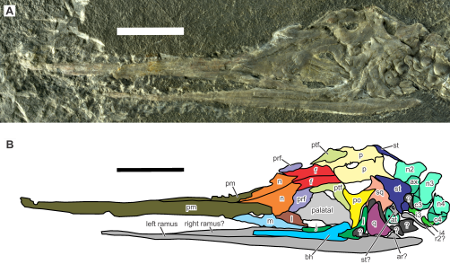2014: A Great Year for Hupehsuchia

I just can’t get enough of those bizarre hupehsuchians! These ancient marine reptiles–known exclusively from ~248 million year old rocks in China–had a tubular, bone-encased torso, toothless jaws, and flippers often sprouting an extra finger and toe or two. In a previous blog post, I noted that they’re probably best described as a “swimming sausage topped with armored mustard”.
Formerly a poorly-known group (both in the literature as well as in general paleontological awareness), Hupehsuchia underwent a scientific transformation in 2014. A wave of newly described specimens has washed through the literature, highlighting the diversity of species and body plans in this group. Additionally, recent studies and new discoveries have clarified their relationships–these animals were probably most closely related to the famous icthyosaurs, or fish lizards. Just in time for the holidays, yet another hupehsuchian has been announced.

Our newest character is called Eohupehsuchus brevicollis, and it’s a tiny thing (full disclosure: I was the handling editor for this paper). The whole body, when complete, might have been less than 30 cm (~1 foot) long, and the head is a little shorter than a typical human thumb. The animal had a relatively shorter neck than many of its close cousins (hence the species name “brevicollis“, which means “short neck”), and its limb bones also happen to be much more ossified than is typical for a hupehsuchian. This feature, among others, suggests that Eohupehsuchus probably isn’t just a tiny juvenile of some larger, better known species; juveniles of most animals tend to have less densely ossified bones than do adults.
There are now a total of four named species of Hupehsuchia, and at least one more is on the way. Remarkably, all of them lived within a fairly small geographic area (<80 km separation between all known fossils) and within a limited time interval (2 or 3 million years, max). Chen and colleagues, the authors on the study naming Eohupehsuchus, speculate that all of these species were able to coexist so happily due to differences in body size and shape–thus indicating different lifestyles that ensured ecological separation.
So…in the year 2014, Hupehsuchia doubled the number of named species. Long-hazy details of anatomy were resolved, and as a result, the evolutionary relationships of hupehsuchians to other marine reptiles are now more certainly known than ever before. Not bad for an armored swimming sausage!
Still craving some hupehsuchian action? Check out my previous posts on other discoveries from 2014!

Citations
Chen X-H, Motani R, Cheng L, Jiang D-Y, Rieppel O (2014) A carapace-like bony ‘body tube’ in an Early Triassic marine reptile and the onset of marine tetrapod predation. PLoS ONE 9(4): e94396. doi:10.1371/journal.pone.0094396
Chen X-H, Motani R, Cheng L, Jiang D-Y, Rieppel O (2014) The enigmatic marine reptile Nanchangosaurus from the Lower Triassic of Hubei, China and the phylogenetic affinities of Hupehsuchia. PLoS ONE 9(7): e102361.doi:10.1371/journal.pone.0102361
Chen X-H, Motani R, Cheng L, Jiang D-Y, Rieppel O (2014) A small short-necked hupehsuchian from the Lower Triassic of Hubei Province, China. PLOS ONE 9(12): e115244. doi:10.1371/journal.pone.0115244
